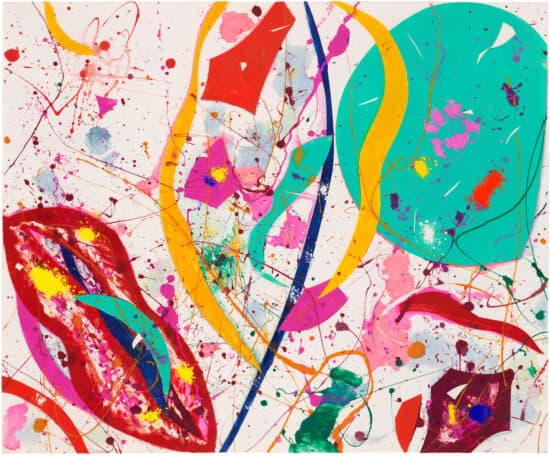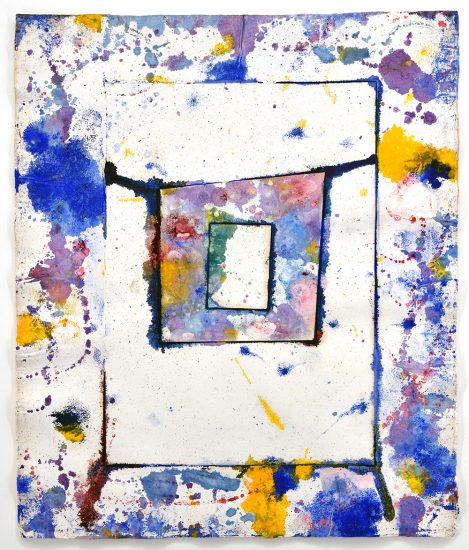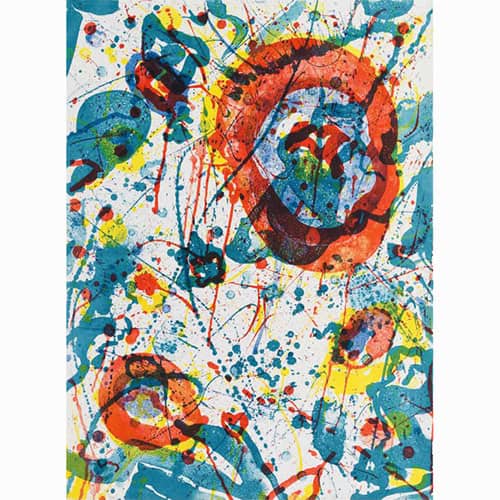Sam Francis was born and raised in California and had multiple studios across the state, but the artist spent a considerable part of his career abroad. With studios in Paris, Tokyo, Bern, Mexico City, and New York, his work was influenced by his connections around the globe. His time in all of these places impacted his artistic output, but perhaps none as importantly as Tokyo. Francis formed both artistic and personal connections while in Japan, first traveling there in 1957 and returning to Tokyo in the 1960s, that would create an East-West cultural dialogue that would impact both his work and emerging artistic movements in Japan, including the Gutai and Mono-ha movements.
When Francis arrived in Japan, his approach to painting instantly appealed to collectors, artists, and art-lovers. His dynamic abstract works shared an aesthetic and philosophical logic with Japanese forms; Francis’s tendency toward sweeping lines paired with a great deal of white space was reminiscent of traditional Japanese landscape paintings, and his loose brushwork recalled the “hatsuboku” (flung, or splashed, ink) style, which emphasizes undefined forms and splattered ink. This common ground allowed him to easily slip into dialogue with Japanese artists across time periods. Comparisons were often drawn between his work and traditional Japanese landscapes. His 1957 work Japan Line, for example, exhibits splattered colors and a large amount of white ground, allowing the canvas’ single zig-zagging line to guide the viewer’s eyes. Its diagonal axis creates an impression of depth and distance, furthering a connection to the style of traditional landscape painting.

Contemporary artists, poets, and critics engaged with and advocated for Francis’s work, strengthening his relationship to not only Japanese artistic forms, but to avant-garde Japanese artistic circles.
The importance of negative space came naturally to Francis, who was artfully working patches of bare canvas into even his early works. The strength of his relationship to the Japanese concept of “ma” was equally natural to the artist. “Ma,” translated as “gap,” “space,” or “pause,” stems from a Japanese emphasis on totality, explored through the relationship between form and non-form. Rather than viewing negative space as an unimportant or secondary aspect of an artwork’s composition, “ma” considers empty space just as highly as the rest of the work. Empty space is seen as the space necessary to give energy and power to the brushstrokes and what guides the viewer through a work or a scene. Exploring “ma” and its compositional possibilities pushed Francis to experiment with negative space in new ways. One of his most radical uses of negative space came in his Edge paintings, created in the 1960s, which centered the white void, pushing brushstrokes and colors to the edges of the canvas. The white space dominates the work and confronts the viewer, while the surrounding active brushwork activates the white space, questioning the traditional Western relationship between figure and ground.
In the 1970s, his use of “ma” became less extreme, but he never lost sight of the tension between positive and negative space. Following the Edge series, Francis’s compositions were less sparse, moving onto series such as his Matrix series, whose compositions were plotted around grid formations. Splitting the surface into squares mirrored the Edge series, as the center of each square was, for the most part, left blank, all of the color still relegated to the peripheries. In his more organically inclined works, the blank spaces were still championed, often serving as the connecting force for his free-floating forms. Even in his densest compositions, Francis was sure to never cover his surface, hints of white giving a viewer’s eyes a chance to rest and a bit of guidance while darting through an array of colors.
Francis’s treatment of negative space, either allowing it to dominate a work or to envelop his other forms, became his oeuvre’s distinctive feature. Francis created over 1,000 artworks during his time in Japan, making his Tokyo studio one of his most prolific locales (second only to his native California). His lyrical brushwork and vivacious colors seated him firmly within an American and European wave of Abstract Expressionism, but what makes Francis’s work stand out amongst this crowd is his application of Japanese influences.
Enjoy our fine art collection of California artist Sam Francis.






